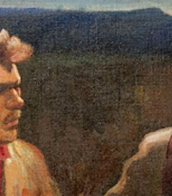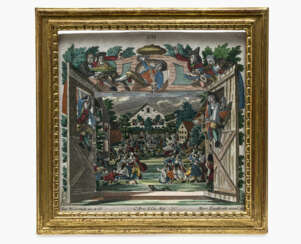martin engelbrecht (1684 - 1756)

Martin Engelbrecht was a German Baroque painter and engraver, publisher, and inventor of the first miniature dioramas.
Martin and his brother Christian were skilled printers and engravers in Augsburg, Germany in the 18th century. Martin's works include illustrations for Ovid's Metamorphoses, The War of the Spanish Succession, P. Dekker's Les Architectes Princiers, 92 views of Venice, and the Assemblage Nouveau Des Manouvries Habilles, a series of engravings depicting laborers and their clothing, published in Augsburg around 1730.
Also around 1730. Martin Engelbrecht created maps for miniature theaters, which, inserted into a display box, showed religious scenes and pictures of everyday life in three-dimensional perspective. He devoted an entire series to Italian theater. These miniature theaters or Engelbrecht dioramas are considered the earliest paper theaters in history, and they became very popular in the 18th century as a means of home entertainment. Engelbrecht is known to have created at least forty-one sets of miniature theater dioramas.


Gottfried Bernhard Göz, also Goez, Goetz, or Götz was a German Rococo painter and engraver.
He worked for many years painting frescoes in chapels and monasteries, and then took up engraving. Göz established his own publishing and engraving business, inventing a printing device that allowed him to produce colorful copperplate prints with shades similar to those of painting.

Martin Engelbrecht was a German Baroque painter and engraver, publisher, and inventor of the first miniature dioramas.
Martin and his brother Christian were skilled printers and engravers in Augsburg, Germany in the 18th century. Martin's works include illustrations for Ovid's Metamorphoses, The War of the Spanish Succession, P. Dekker's Les Architectes Princiers, 92 views of Venice, and the Assemblage Nouveau Des Manouvries Habilles, a series of engravings depicting laborers and their clothing, published in Augsburg around 1730.
Also around 1730. Martin Engelbrecht created maps for miniature theaters, which, inserted into a display box, showed religious scenes and pictures of everyday life in three-dimensional perspective. He devoted an entire series to Italian theater. These miniature theaters or Engelbrecht dioramas are considered the earliest paper theaters in history, and they became very popular in the 18th century as a means of home entertainment. Engelbrecht is known to have created at least forty-one sets of miniature theater dioramas.


Martin Engelbrecht was a German Baroque painter and engraver, publisher, and inventor of the first miniature dioramas.
Martin and his brother Christian were skilled printers and engravers in Augsburg, Germany in the 18th century. Martin's works include illustrations for Ovid's Metamorphoses, The War of the Spanish Succession, P. Dekker's Les Architectes Princiers, 92 views of Venice, and the Assemblage Nouveau Des Manouvries Habilles, a series of engravings depicting laborers and their clothing, published in Augsburg around 1730.
Also around 1730. Martin Engelbrecht created maps for miniature theaters, which, inserted into a display box, showed religious scenes and pictures of everyday life in three-dimensional perspective. He devoted an entire series to Italian theater. These miniature theaters or Engelbrecht dioramas are considered the earliest paper theaters in history, and they became very popular in the 18th century as a means of home entertainment. Engelbrecht is known to have created at least forty-one sets of miniature theater dioramas.


Christoph Weigel the Elder, full name Johann Christoph Weigel, was a German painter, engraver and publisher.
Weigel worked very successfully in the mezzotint technique. He was the first engraver to use a kind of machine for making backgrounds. He established his own printing house in Nuremberg in 1698, and worked closely with the imperial geographer and cartographer Johann Baptist Homann (1664-1724) to produce his maps. His younger brother Johann Christoph Weigel kept an art trade store in Nuremberg around the same time, and also quite successfully.
One of Weigel's most important works is the Ständebuch (Book of Classes) of 1698, which describes and illustrates with engravings more than two hundred trades and services, including mining.










![[ENGELBRECHT, Martin (1684 - 1756); incisore] - REDEL, August Casimir - Elogia Mariana olim a A.C. Redelio Belg. Mechl. S.C.M.L.P. concepta. [S.L.: s.e., 1732].](/assets/image/picture_1242068/c80dd/7mjpizkgch9h4utxxx4g-8wrwnglm1iafz7uo3w53chepar7juehnmpe3xystda1608650265jpg__fix_374_244.jpeg)
![[ENGELBRECHT, Martin (1684 - 1756); incisore] - REDEL, August Casimir - Elogia Mariana olim a A.C. Redelio Belg. Mechl. S.C.M.L.P. concepta. [S.L.: s.e., 1732].](https://veryimportantlot.com/assets/image/picture_1242068/c80dd/7mjpizkgch9h4utxxx4g-8wrwnglm1iafz7uo3w53chepar7juehnmpe3xystda1608650265jpg__fix_374_244.jpeg)






































